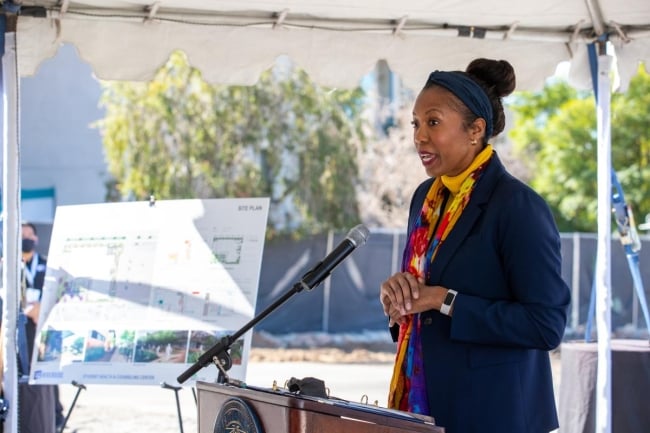You have /5 articles left.
Sign up for a free account or log in.

The Division of Health, Well-being and Safety, headed by Denise Woods, combines police and health services under one roof.
University of California, Riverside
When somebody on the University of California, Riverside, campus commits a low-level infraction—such as playing music too loudly or riding their bike unsafely—campus police don’t get involved. Instead, campus safety responders are called in—unarmed individuals tasked with handling situations that don’t necessarily require police carrying weapons.
Four campus safety responders were hired in the summer of 2021, with more likely to come.
Along the same lines, UC Riverside is preparing to implement a new team of behavioral health specialists—known as Student Well-being, Intervention and Follow-Through, or SWIFT, counselors—to respond to individuals experiencing mental health crises (although campus safety responders are also trained in de-escalation). A vehicle called the SWIFT van, not a police car, will transport those students if needed.
“It’s less triggering,” said Associate Vice Chancellor Denise Woods. “If we have a student who has a mental health crisis and they need to go to the hospital, they don’t have to ride in the police car. So, we’re just trying to incrementally pull out our police from being in situations where they’re not necessarily needed for that type of support.”
These are just some of the initiatives that the university in Southern California, which enrolls over 26,000 students, has taken to reduce the presence of police and make the campus safer over all. The university has also combined a number of departments—including, among others, the basic needs department, the counseling center and the police—under one roof: the Division of Health, Well-being and Safety, which Woods heads.
New Safety Guidance
UC Riverside’s efforts to decrease the number of police responses on campus comes in part from work done in the aftermath of George Floyd’s murder by police in 2020—though Woods says conversations about “how the campus could be more inclusive” had begun the year prior.
The steps the university has taken mirror those adopted by cities across the United States since 2020 to provide alternative options to police, especially for citizens experiencing mental distress. One study indicated that individuals with untreated mental illness are 16 times more likely than the general population to be killed by police.
In Eugene, Ore., for example, a team of crisis responders called CAHOOTS, or Crisis Assistance Helping Out on the Street, has been providing people with mental health support, medical care and other resources since 1989. In 2017, the team handled 17 percent of the city’s 911 calls, according to The Wall Street Journal.
Other cities, including Oakland, Calif., have begun replicating the CAHOOTS model or something similar.
“We are [required] to meet people where they are and display empathy to find out what is going on with them,” the manager of Oakland’s program (called Mobile Assistance Community Responders of Oakland) told The San Francisco Chronicle in 2022, shortly after it launched. “We want to offer them some sort of service, whether it’s a soda or some water, a piece of chocolate, blanket or some socks. If eventually you decide you want service, you want to get off the streets, you want help, then … we will connect you to services in Alameda County.”
UCR’s model was inspired in part by CAHOOTS, as well as by recommendations presented by both the university’s Campus Safety Task Force and a set of campus safety guidelines released by the University of California system in 2021 to “ensure that all members of the community feel welcomed, respected and protected from harm.”
The creation of this systemwide resource had been a top priority of UC president Michael V. Drake, according to the Los Angeles Times. Among other things, the systemwide guidance calls on universities to hire a range of emergency responders and to define each role’s responsibilities.
How College Campuses Differ
Experts are encouraged to see tiered response models expanding from cities and towns to campuses.
Michele Weinzetl, a retired police officer and a consultant who works with police departments to figure out alternative response models, said such approaches could be especially impactful on college campuses, where a significant portion of students may be dealing with mental health issues.
“Across the country, access to mental health services has declined, and there are growing concerns among various professionals about the lack of mental health services across our service spectrum, I think, nationally,” she said. “I would argue that college-aged people represent a large portion of those who struggle with various mental health needs. They also are oftentimes removed from their significant support systems.”
She noted that implementing such programs on college campuses presents challenges that don’t exist elsewhere; because of the academic year calendar, for example, there will likely be less demand for mental health responders during the summer, which “complicates the staffing model,” Weinzetl said.
UCR isn’t alone in trying to adapt such a model to a university setting; other campuses, including Oregon State University and California State University, Long Beach, have launched similar mobile crisis response programs in recent years.
Some experts argue that efforts to combine mental health care, medical care, policing and other services in one department haven’t always succeeded.
“The idea of merging care teams and police officers into a single public safety department has been discussed in quite a few places, but has rarely if ever been actually implemented. There are substantial data sharing, supervision, certification/licensure, and information access barriers to merging these separate fields into a single unit,” said Lisa Daugaard, a criminal justice reform activist and the director of the nonprofit Public Defender Association, in an email to Inside Higher Ed. “In some situations where this has been explored, it’s become clear that the administrative costs alone of making this transition would consume funding that was urgently needed to expand housing, shelter, mental health and drug user health responses. We’re interested to follow this proposed move at UC Riverside to understand any solutions they’re able to arrive at for these practical barriers and costs.”
Woods acknowledged that “there is no real blueprint for what we’re doing,” beyond programs like CAHOOTS. She said she has drawn in part upon her background in public health to inform UCR’s public safety experiment.
“We’re using, really, a collective impact model here, where our Health, Well-being and Safety Division is—it’s kind of the backbone organization, and then we’re relying on campus stakeholders and different schools and partners internally to be able to work with them to have these common goals,” she said.








